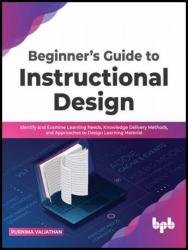 Название: Beginner’s Guide to Instructional Design: Identify and Examine Learning Needs, Knowledge Delivery Methods, and Approaches to Design Learning Material
Название: Beginner’s Guide to Instructional Design: Identify and Examine Learning Needs, Knowledge Delivery Methods, and Approaches to Design Learning MaterialАвтор: Purnima Valiathan
Издательство: BPB Publications
Год: 2022
Страниц: 244
Язык: английский
Формат: pdf, epub (true), mobi
Размер: 10.19 MB
Applying instructional design principles to serve content just right!
Key Features
- Covers concepts and methodologies for determining the learning objectives, study content, and the mode of delivery.
- Exclusive coverage of best practices for designing education and workplace training material.
- Includes strategies for designing and delivering online and classroom learning content.
Description
This book aims to give instructional designers a better understanding of how learning science can be used in their work. Four real-world case studies illustrate educational needs and the associated solution, bridging theory and practice. Professionals can use the book's templates and formats to create job aids, virtual training, and online learning storyboards.
The prominent ADDIE methodology for instructional material development is used throughout the book. The ADDIE model's phases are taught and demonstrated using a variety of real-world scenarios. Gagne's Events of Instruction, Kolb's Experiential Model, and Merrill's Principles of Learning are just a few of the foundational frameworks thoroughly presented with the examples. This book provides examples to show assessment strategies for verifying declarative knowledge and assessment tools for evaluating procedural knowledge. Information about authoring tools, LMSs and LXPs are also covered.
After studying the Chapter 7, you will be able to describe the following terms – synchronous learning, asynchronous learning, blended learning, and flipped learning. In addition, you will understand how software, such as learning management systems (LMS) and learning experience platforms (LXP) help us deliver online learning. You will also learn how the design and delivery of online learning is different from classroom teaching. Finally, you will know the challenges faced in virtual teaching and some best practices to address these.
Synchronous learning refers to an instructor or teacher addressing a group of learners virtually. Interaction between the teacher and learners and among the learners happens in real time. Typically, video conferencing software, such as Zoom, Microsoft Teams, or Google Meet is used for this purpose.
Learning management systems (LMS) is the software that is used to deploy and track online learning. Typically, self-paced courses developed by applying the instructional design process are uploaded to the LMS, which are then accessed by learners virtually. So, LMS is a virtual library of sorts. Anyone with a login and password can access these online resources whenever and wherever. LMS acts as a repository with a catalogue of structured courses. It also makes administrative tasks, such as storing learner records and tracking course completion status easy. LMSs can be proprietary or open source. Open source means that you can use the software without purchasing a license. Moodle is an example of an open-source LMS.
The increasing role of social media in our day-to-day lives has impacted the way we learn as well. What started off as virtual spaces to connect, morphed into virtual spaces to learn and share. LinkedIn, Pinterest, and Twitter became platforms where members could learn, share, and publish content. YouTube began to be increasingly used by people to publish the videos they created – especially “How To” tutorials. Added to this, smart phones made it easy to access and share content anytime, anywhere. So, basically, content authoring and publishing that happened within a closed system like the LMS were thrown open to anyone who wished to create and share content.
LMSs didn’t provide the collaboration and learning features that social networking platforms offered. Neither did it track data related to these informal means of learning. Last, but not the least, most LMSs were not compatible with mobile phones. It is in this scenario, that Learning experience platforms (LXP) emerged. Unlike LMS, which is a closed platform, where administrators control content, LXPs allow users to aggregate and curate content. It offers greater user control than the traditional LMS. In addition, it can be integrated with other systems, such as human resource systems, and is also mobile compatible. Also, unlike LMS, LXPs are designed to track informal and social learning as well. In this type of learning, students or learners learn from each other, as against learning from a teacher or a formal course. In other words, individuals collectively seek and find relevant content from various sources. Some LXPs are also Artificial Intelligence (AI) driven.
What you will learn
- Create synchronous and asynchronous online learning resources.
- Acquire familiarity with authoring tools and learning management systems.
- Conduct a job analysis to identify skill development and workplace learning opportunities.
- Examine the audience profile for educational, professional, and performance objectives.
- Assemble lesson plans for online training sessions.
Who this book is for
This book is intended for traditional educators, academics, corporate trainers, and instructional designers who wish to improve their knowledge of modern teaching techniques and give their audience a methodical and dynamic learning experience. The book is accessible to everybody, making no assumptions about the reader's past knowledge.
Скачать Beginner’s Guide to Instructional Design: Identify and Examine Learning Needs, Knowledge Delivery Methods